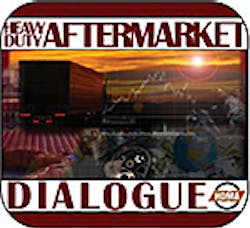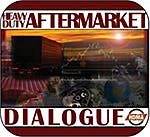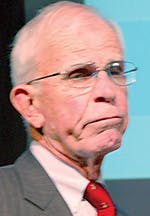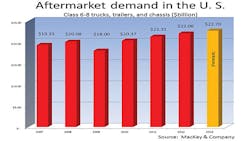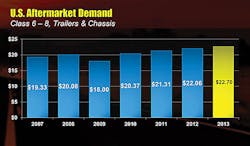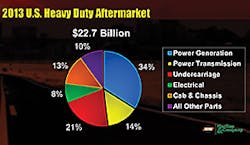Heavy Duty Dialogue: Aftermarket thrives from positive impact of fitness factors
THE average vehicle age increased two months in 2013 and is now 10 years, which is as high as it’s ever been, according to Stu MacKay, president of MacKay & Company.
“That’s having an impact on the aftermarket because of the older vehicles and the fact we’re getting into some replacements and more downstream overhauls with older equipment,” he said.
Class 8 fleet utilization was up one percentage point to 84%, and although he expects it to pull back a bit, “we are still strongly ahead of where the market bottomed in 2009” at 81%.
Average prices are up about 1.8% and the total aftermarket is up about 2.9%, he said.
What hasn’t changed much since last year:
• Operating vehicle universe. “Most of what’s been purchased in the last year or two has basically been replacement—trucks being sold, downgraded, scrapped, or exported, and replacements being put in place. As a result, there’s been very little change.”
• Annual mileages.
• Overall number of distribution outlets. “While the composition changed with acquisitions and divestitures and changes in ownerships, the absolute number of points of purchase is pretty much the same as 12 months ago.”
• Distribution channel market shares.
• Vehicle utilization.
The 2013 US operating population was 8,967,000 vehicles: 2.8 million Class 8 vehicles, 4.6 million trailers/container chassis, and 1.5 million Class 6-7 vehicles.
“We never really tracked container chassis’ impact on the aftermarket until the last few years, and with the growth of intermodal activity, it’s becoming a much more significant piece of the rolling universe,” he said. “There’s relatively low mileage per unit, but there are a lot of them.”
For-hire carriers account for 30% of Class 8 vehicles and 42% of trailers and container chassis, while school buses account for 24% of the Class 6-7 market.
In US Class 8 fleet utilization, there has been a decline every year from 88% in 2005 to 81% in 2009, then it’s been flat at 83% every year since.
“The 400-carrier utilization rate is in mid 90s,” MacKay said. “The flip side is that construction is in 50s and the agricultural market is in the low 40s, high 30s. So there’s a wide variety in terms of the various vocational utilization rates, but the net result is 83, which is pretty solid.”
In average annual miles, Class 8 is at 75,130—including 25,000 in construction fleets and 225,000 in high-intensity long haul—while trailers are at 59,450.
The US heavy-duty aftermarket in 2013 was $22.7 billion, split among: power generation (34%), undercarriage (21%), power transmission (14%), cab and chassis (13%), electrical (8%), and all other parts (10%).
In US aftermarket demand for Class 6–8 vehicles and trailers and chassis, the low was $18 billion in 2009 but has risen every year to $22.7 billion in 2013.
“It has bounced back fairly solidly from 2009,” MacKay said. “We are a good distance from where we were not that long ago.”
The demand by vocation: for-hire carriers (31%), private (18%), lease/rent (14%), construction (12%), agriculture (6%), school bus (4%), and government (4%).
The demand by fleet size: greater than 500 units (36%), 100-499 (17%) 25-99 (15%), 10-24 (12%), and less than 10 (20%).
“That has not changed over the last several years,” MacKay said.
Aftermarket demand channel shares: OE dealer (42%), heavy-duty distributor (18%), independent garage (14%), specialist (8%), auto parts (6%), engine distributor (6%), and other (6%).
“It’s been this way for the last two or three years,” he said. “Engine distributor share has been going down as we move to more proprietary engines. In the early 1980s, the auto parts channel had 18% of the heavy-duty aftermarket. There were a lot of gas engines and hydraulic brake vehicles, and basically they are not out there now.”
The Class 8 utilization rate peaked at 87.9% in 2005 and bottomed out at 81.3% in 2009, and is now at 84.3%.
Average annual kilometers: Class 8, 111,930; trailers, 78,270; and chassis, 4560.
The 2013 Canadian heavy-duty aftermarket was $3.5 billion, split between power generation (32%), undercarriage (23%), power transmission (13%), cab and chassis (9%), electrical 8%, and all other parts (15%).
Aftermarket demand by vocation: for-hire (26%), agriculture (20%), construction/mining (15%), private (13%), government (4%), lease/rent (7%), school bus (2%), and refuse (1%).
By fleet size: greater than 500 (29%), 100-499 (14%), 25-99 (14%), 10-24 (11%), and less than 10 (32%).
Aftermarket demand channel shares: OE dealer (43%), heavy-duty distributor (17%), independent garage (15%), specialist (7%), engine distributor (7%), and auto parts (6%).
Factors Affecting the Trucking Economy
Bob Dieli, president and founder
RDLB Inc
Trucking’s economic activity should maintain its growth through this year as the overall economy continues its expansion, according to Bob Dieli, president and founder of RDLB Inc.
While admitting “they call them surprises for a reason,” Dieli said “the risks of a recession are quite low, especially in the near future.”
Dieli identified five major components in the overall economy that create what he calls Truckable Economic Activity (TEA): consumption, investment, exports, imports and government. And all five should “see a fairly steady expansion this year,” he predicted.
• On total TEA: “The gains from 2013 should be sustained through 2014.
• On consumption: “Income and employment growth are the keys.”
• On investment: “Spending on equipment will be the main driver.”
• On exports: “Improved conditions overseas should provide a boost.”
• On imports: “Likely to mirror consumption growth.”
• On government: “State and local should be a plus. Federal austerity should continue.”
Leading the growth will be strong import and export activity, both of which require trucks, Dieli said. By his estimate, the two now account for almost 25% of all truckable economic activity, compared to 19.5% in the decade of the 2000s and 17.5% in the 1990s. The growth of foreign trade is one of the recent key structural changes to the economy “that will be with us for a long time,” he said.
“One of the major changes that has taken place in the way goods move through the economy is where they originate and where they are going,” he said. “Before, we had to pay less attention to what happened overseas. Now we have to pay more.”
Driven by income and employment growth, overall goods consumption will also be a strong factor in improved trucking industry performance, Dieli said. He estimated that it now accounts for almost 45% of trucking economic activity, compared to just over 40% in the 2000s.
He said TEA softened before the recession started. The forecast for this year is that the enhanced aggregate spread says “we should be well above the danger zone associated with recessions, and we should also continue to see steady expansion of TEA.”
“All of components except for government and investment have gone well beyond where they were, which is part of the reason why we have moved into the expansion rather than the recovery phase of the cycle,” he said.
He said that growth in truck sales tends to reflect growth in freight volumes, “but as we saw, not all that closely, because truck sales seem to have a mind of their own.”
His conclusions:
• The expansion phase is likely to continue through 2014.
• Major changes in fiscal and monetary policy are not expected in the near term because of the budget agreement and the changing of the guard at the Federal Reserve.
• Further adjustment, some of it quite painful, to structural changes in the economy will continue. “Structural change is the hallmark of this event and is one of things that will be with us for quite a while.”
The fundamental industry questions remain the same: Who will buy the trucks? Who will sell the trucks? Who will fix the trucks?
Bill Strauss
Senior economist, Chicago Federal Reserve
Strauss said he is very pleased to see the indicators well above the recession zone.
There was 2.3% growth on an annualized rate, but he expects that to accelerate to 3% in the next three years, with inflation remaining contained to below 2%.
“As we highlighted, the labor markets are still challenged,” he said. “We won’t get close to normalization until the end of 2016.”
Responding to a question about the Fed and interest rates, he said, “Even when rates go higher, that does not necessarily imply that conditions in the economy deteriorate. You have to ask yourself, ‘Why is the Fed doing it?’ We’re going to see better rates of growth than we have seen in the past five years.”
He also read questions from the attendees and posed them to Dieli.
Q: What are the risks on the horizon?
Dieli: I divide risk into two categories. We have the stuff associated with the variables themselves. One of the things that happens is they have a fair amount of trend. And there’s not a whole lot of that out there now. Things that are rising now will continue to rise until something happens to provide a formal restraint. We get surprised. Events can conspire to make people worry or to interrupt the flow of goods and services, which can have consequences. But I think the risk of a recession generally is quite low, especially in the immediate horizon. The model functions with a forecast horizon of a year. It can’t see beyond that. The analogy being your headlights. You can overrun your headlights at night. If you drive faster than the beam extends, you are effectively driving with no lights. Now is there something on the other side of horizon? I can’t tell, but I am constantly adjusting that horizon to make sure that we’re looking out there.
Q: What are the risks in America versus foreign locations?
Dieli: It’s not that there’s no risk here. China is a special case for a variety of different reasons, not only in size but in the interaction with our economy—as compared to Turkey or Argentina. We interact with Turkey and Argentina, but an event there that would have economic consequences here is pretty hard to imagine. Not so with China. If there were major changes with what they’re doing in terms of importing, exporting, or other relationships, that would increase the risks to us. This might be slightly overdramatic but it could be an OPEC type of consequence. The first OPEC happened in 1973, but it was OPEC II in the ‘80s that put us into a different mindset as to how we built cars. China has that thing—both a short-term consequence and also long-term impact.
Q: How and why is the new Fed chairman (Janet Yellen) qualified to lead our monetary policy?
Dieli: First of all, the man is a woman. Based on her experience, she had a distinguished career in macroeconomic policy. She had been vice chair of the Fed for several years, and prior to that had been president of the Fed in San Francisco. So if you’re going to look at it as someone’s resume in training and experience, she’d be a perfectly acceptable candidate. I will say this: She was everyone’s second choice, and this, I think, is a factor. I don’t think the markets wanted her as their first choice. I don’t think the President wanted her as his first choice. There were other candidates considered. I think that will be one of the problems she has to overcome. But thinking back to other Fed chairs, Paul Volcker was not the choice of the business community and Alan Greenspan got the job because he was the most famous guy at the time. He had previously no experience in the Fed. We’re going to find out, as we have with all of them, on issues of temperament, how they manage the institution, and how they choose to communicate to us their decisions on monetary policy. ♦
___________________________________________________
This story was based on presentations at the recent Heavy Duty Aftermarket Dialog sponsored by the Heavy Duty Manufacturers Association and MacKay & Company. For information about next year’s even contact HDMA (www.hmda.org) For more information regarding MacKay & Company, visit www.mackayco.com.
About the Author
Rick Weber
Associate Editor
Rick Weber has been an associate editor for Trailer/Body Builders since February 2000. A national award-winning sportswriter, he covered the Miami Dolphins for the Fort Myers News-Press following service with publications in California and Australia. He is a graduate of Penn State University.
